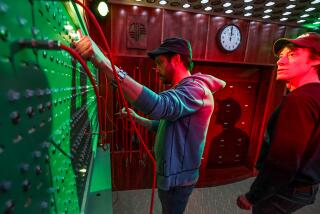One Thing Leads to Another With Discovery’s Connections
- Share via
Most of us don’t realize how interconnected our technologies are.
Consider the humble match. It consists of a small stick topped by a head of phosphorous. When exposed to oxygen, phosphorous ignites.
The real secret behind the match is paraffin wax, which is mixed in with the phosphorous. Scraping the match against a rough surface exposes some of the phosphorous, which ignites and melts some of the wax. In turn, that exposes more phosphorous to air, creating a slow chain reaction that allows the flame to persist long enough for the wood to catch fire.
So the development of something as simple as a match relied on making a connection between the behavior of phosphorous and the properties of wax.
Such links serve as the basis for Connections, a CD-ROM game from Discovery Channel Multimedia (Windows/Macintosh, $50).
Host James Burke, who has a similar program that airs on cable TV’s Learning Channel, guides you through various settings such as a Medieval castle, a Western town and a Renaissance city so you can learn about the connections among various people and events in history.
It’s a very unusual perspective.
You move around Connections as you would a traditional role-playing game, collecting important objects and solving various puzzles. Some of the objects you find become part of a chain, where each item is linked in some way with the next.
For example, the working steam pump and the predecessor of carbon paper are connected by a common inventor, James Watt, who discovered that drawings made with a mixture of ink and gum would transfer their image onto a piece of damp paper.
Carbon paper and the household match are connected because both require paraffin wax. Inventors discovered that if you took carbon soot, mixed it with paraffin wax and spread it on a sheet of paper, you’d get carbon paper.
The match, in turn, is connected to an oscilloscope because both require phosphorous. The oscilloscope screen uses phosphorous to create its glow. The same principle, in turn, gave us the TV screen.
And on it goes.
Like most Discovery Channel products, this is an education product that plays like a game. But some players may be turned off by the fact that some of the connections Burke makes between objects can seem pretty tenuous.
For example, to connect television and a sword, he observes that TV let us watch the space program, which wouldn’t be possible without alloys, which were pioneered by blacksmiths seeking ways to make tougher, sharper blades.
It’s also possible to get through the game without understanding the connections, which can make Connections seem confusing and, at times, pointless.
Your time might be better spent watching Burke’s TV show.
*
“Volcanoes: Life on the Edge” (Corbis, Windows/Macintosh; $50) makes no pretense to being a game. It’s simply a straightforward, educational look at volcanoes, the people who live in their shadows and the scientists who study them.
Nonetheless, it is a pleasure to experience.
It’s based on the journey of Roger Ressmeyer, who spent 1991-92 on assignment for National Geographic magazine photographing the world’s fiercest volcanoes.
His 400 pictures are spectacular. But “Volcanoes” is much more than a photo album. It offers more than 100 volcano-related articles and slide shows, with just about everything you’d want to know about the topic.
For example, most people don’t realize how many ways a volcano can kill you.
Contrary to what Hollywood disaster movies might make you think, lava isn’t the biggest threat. Fewer than 1,000 people have been fried by lava in the last several centuries. Yet about 100,000 have been killed by volcanic avalanches of super-hot clouds of gases, ash and rock fragments called pyroclastic flows. They can race silently down an erupting mountain at speeds greater than 100 mph.
On May 9, 1902, a pyroclastic flow released by the erupting Mt. Pelee on the Caribbean Island of Martinique washed over the town of Saint-Pierre 4 miles away, killing 30,000 people, in just two minutes. The only survivor, found when he was near death, had been confined in the town jail.
Many of the deaths caused by an erupting volcano are of people who refuse to leave their homes or of spectators who believe they’re watching from a safe distance.
“Volcanoes” will teach you to give these explosive mountains the respect they deserve.






